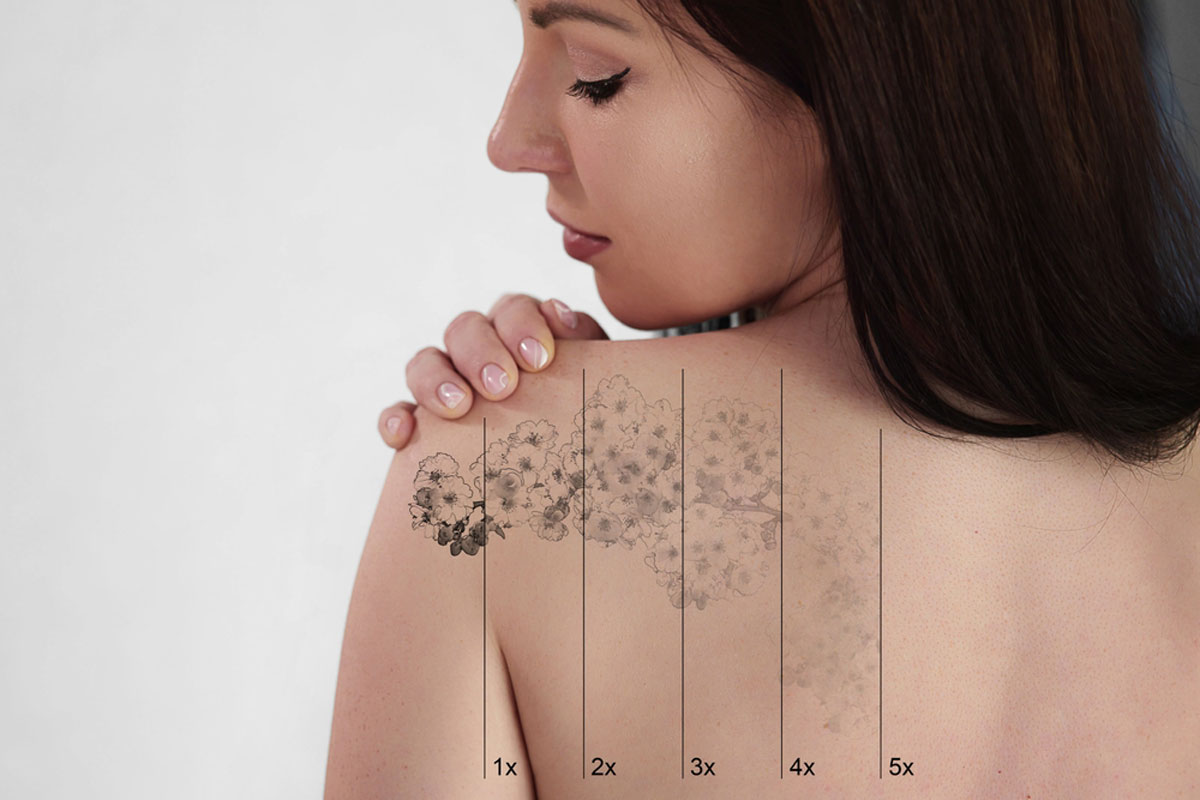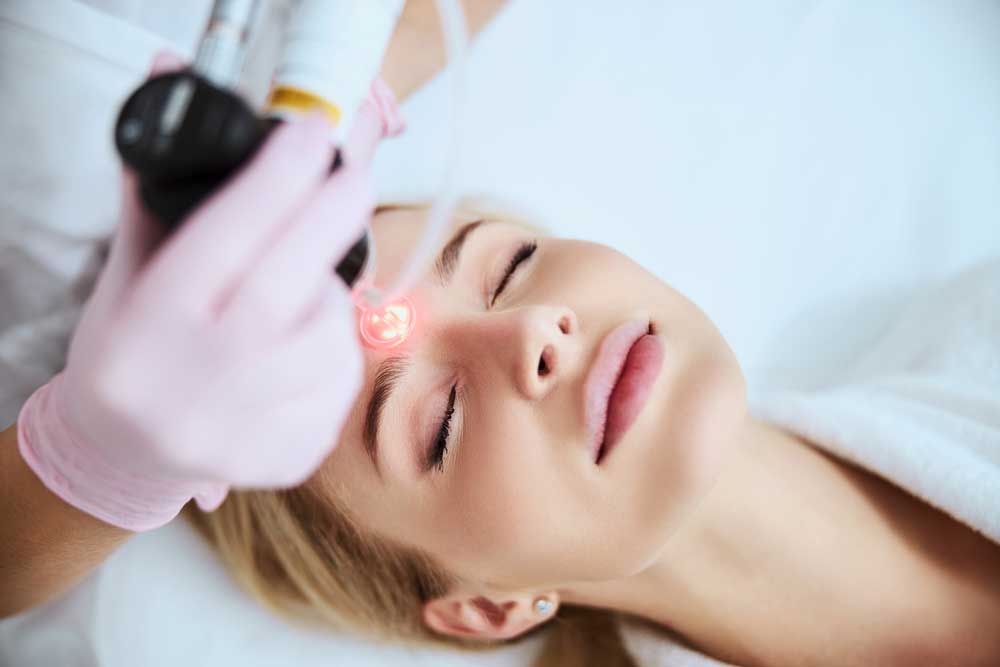With minor breakouts, our skin may be able to heal perfectly with no visible signs that there was ever a blemish. However, people who have the most painful and severe types of acne may also find themselves with more severe scarring down the road.
While some topical products can help encourage an improvement in the texture and health of the skin, severe acne scars need a more direct treatment because of the amount of tissue that can be damaged during a breakout of cystic or other forms of inflammatory acne. Our acne scar treatments can help to resurface and heal the skin from the inside out for an overall improvement in texture, tone, and clarity.
How Acne Scars Form
The Acne Breakout
When an acne lesion forms, it’s a result of several underlying processes happening within your skin. Initially, the pore becomes clogged with excess sebum and dead skin cells, creating an environment where bacteria can thrive. This bacterial growth triggers an immune response, leading to inflammation and the accumulation of pus, which can cause tissue damage in the surrounding skin. This damage is not just at the surface but also affects deeper layers of the skin, disrupting the normal structure and leading to the potential for acne scars.
Your Body’s Healing Process
After an acne lesion damages the skin, your body initiates a healing process. Ideally, this involves the formation of new collagen fibers to repair the damaged tissue. However, the healing process isn’t always perfect. Sometimes, the skin produces too much collagen, leading to raised scars. In other cases, there’s not enough collagen, resulting in depressed scars. These deficiencies in the healing process are what lead to the permanent textural changes in the skin known as acne scars. Factors like the severity of the acne, the delay in treatment, and individual skin characteristics can influence how well your skin heals and whether scars develop.
The Lifespan of a Scar
Initially, the acne scar healing process can make the scar appear more pronounced, with redness or hyperpigmentation making it stand out against your regular skin tone. Over time, however, the color typically fades, and the scar may become less noticeable. This process can take years, and the final appearance of the scar will vary. Some scars may soften and blend more into the surrounding skin, while others remain visible. The extent to which a scar heals and fades depends on factors like the scar’s depth and size, your skin type, and any treatments you may use to promote healing and reduce scar appearance.
What Are the Different Types of Acne Scars?
- Ice Pick Scars: These are deep and narrow, resembling puncture marks that extend into the dermis. This type of acne scar is difficult to treat because of its depth.
- Boxcar Scars: Round or oval with steep sides, this type is wider than ice pick scars and gives the skin a pitted appearance due to tissue loss.
- Rolling Scars: These are wide, shallow scars that create a wave-like texture on the skin, caused by damage beneath the surface.
- Hypertrophic Scars and Keloids: These are raised scars that stay within the injury site (hypertrophic) or grow beyond it (keloids), resulting from excessive collagen during healing.
A Few Common Factors in Acne Scarring
Inflammation
Inflammation is a significant factor in the development of acne scars. When acne forms, the skin becomes inflamed as part of the body’s response to bacteria and dead skin cells clogging pores. The more severe the inflammation, the higher the chance of scarring. Deep, inflamed acne lesions, such as cysts and nodules, are more likely to leave behind scars because they affect deeper layers of the skin and cause more significant damage.
Picking at or Aggravating Acne
Picking at or aggressively treating acne can worsen scarring. The act of picking not only spreads bacteria, increasing inflammation, but also interrupts the natural healing process of the skin. When acne lesions are squeezed or picked, the action can push bacteria and pus deeper into the skin, leading to more significant tissue damage and increasing the likelihood of scarring.
Genetic Factors
Genetics can be part of determining who is more likely to develop acne scars. If your family members have a history of acne scarring, you might be more predisposed to experiencing them as well. Genetic factors can also influence how your skin responds to inflammation and heals from injuries, as well as how much collagen your skin produces during the healing process. These genetic predispositions mean that some individuals might experience more severe scarring even from relatively mild acne.
Acne Scar Treatment Options
Morpheus8 RF Microneedling
Morpheus8 RF microneedling combines microneedling with radiofrequency energy to rejuvenate the skin by promoting collagen production. This acne scar treatment targets the deeper layers of the skin, encouraging a healing response without damaging the top layer of skin. It’s a non-invasive option that improves the texture and appearance of acne scars over the course of several treatments.
How It Works for Acne Scars
Morpheus8 RF microneedling works for acne scar treatment by delivering radiofrequency energy deep into the dermis through tiny needles. This process creates little holes called microchannels in the skin, stimulating the body’s natural healing process and boosting collagen production. The increased collagen can help to fill in and smooth out acne scars, making them less visible and improving the overall texture of the skin. This treatment is particularly effective for atrophic scars, offering a smoother, more uniform skin surface.
Treatments for Post-Inflammatory Hyperpigmentation
Post-inflammatory hyperpigmentation (PIH) occurs when a skin injury or inflammation, such as acne, leaves behind darkened patches or spots. This discoloration happens as the skin heals and produces excess melanin, the pigment that gives skin its color. While PIH can fade over time, treatments can help accelerate the process and even out skin tone.
Lutronic Ultra™
Lutronic Ultra™ is an effective scar therapy option for treating post-inflammatory hyperpigmentation following acne. By using non-ablative fractional energy, it gently resurfaces the skin, encouraging the replacement of damaged, hyperpigmented skin with new, healthier-looking tissue.
Hollywood Spectra™
The Hollywood Spectra™ laser is another acne scar treatment aimed at reducing hyperpigmentation. Its dual-wavelength laser technology exfoliates the skin and breaks down excess melanin, which contributes to dark spots. By stimulating natural collagen and elastin production, it can also help reduce the depth of acne scars while evening skin tone.
Heal Your Skin With Acne Scar Treatments
At RoseHall Medical Aesthetics, we offer advanced acne scar removal solutions that can be used to treat the skin of our patients in Washington, DC, and Bowie, MD. With cutting-edge technologies like Lutronic Ultra™ and Hollywood Spectra™, we can deliver effective results, enhancing your skin’s appearance and health. To learn more about how we can help you achieve clearer skin, please reach out to us via our online form or call us at (301) 383-9819.


